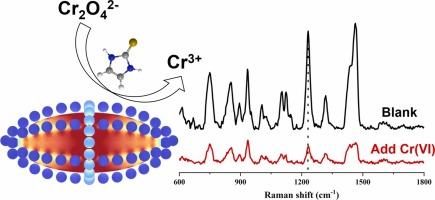用氧化还原介导的表面增强拉曼光谱法快速、选择性和超灵敏地检测复杂样品中的Cr(VI)
IF 3.7
1区 化学
Q1 CHEMISTRY, ANALYTICAL
引用次数: 0
摘要
表面增强拉曼光谱(SERS)在金属离子检测中往往存在选择性、灵敏度和抗干扰能力差的问题。本文提出了一种氧化还原介导的SERS方法,用于复杂样品中Cr(VI)的现场检测,具有超高灵敏度(2.6 fmol/L)、选择性和快速(5 min内)。之所以选择2-巯基咪唑作为SERS探针,是因为它具有较强的SERS活性,并且其巯基能够将Cr(VI)还原为Cr(III)。研究了Cr(VI)与2-巯基咪唑的巯基在酸性条件下的氧化还原反应,包括pH、混合比、温度和浓度。值得注意的是,反应在1分钟内达到平衡。此外,由于其强氧化性,该方法对Cr(VI)的选择性高于其他离子,并且由于强大的硫-金属键形成,该方法具有出色的抗干扰能力。氧化还原介导的SERS方法灵敏度超高,检出限为2.6 fmol/L,比美国环保局规定的饮用水安全水平(0.1 mg/L)低12个数量级。最后,将该方法成功应用于环境水和中药饮用样品(党参、黄芪)中Cr(VI)残留的检测,回收率为85.5% ~ 110%,rsd较低(0.1 ~ 4.2%)。这项工作不仅提高了现场检测Cr(VI)残留的分析性能,而且为公共安全监测和药品质量控制提供了一个具有重大意义的多功能工具。本文章由计算机程序翻译,如有差异,请以英文原文为准。

Rapid, selective, and ultrasensitive detection of Cr(VI) in complex samples by a redox-mediated surface-enhanced Raman spectroscopy method
Surface-enhanced Raman spectroscopy (SERS) often suffers from poor selectivity, sensitivity, and anti-interference capabilities in metallic ions detection. Herein, a redox-mediated SERS method is presented for on-site detecting Cr(VI) in complex samples with ultrahigh sensitivity (2.6 fmol/L), selectivity, and rapidity (within 5 min). 2-Mercaptoimidazole was selected as the SERS probe due to its strong SERS activity and the ability of its thiol group to reduce Cr(VI) to Cr(III). The redox reaction between Cr(VI) and the thiol group of 2-mercaptoimidazole under different conditions was investigated, including variations in pH, mixing ratio, temperature, and concentration. Remarkably, the reaction equilibrium was achieved within 1 min. Furthermore, the method exhibited high selectivity for Cr(VI) over other ions due to its strong oxidizing properties, and excellent anti-interference capabilities attributed to the robust sulfur-metal bond formation. The redox-mediated SERS method with ultrahigh sensitivity and a detection limit of 2.6 fmol/L, which is 12 orders of magnitude below the safety level (0.1 mg/L) set by United States Environmental Protection Agency for drinking water. Finally, the method was successfully applied to detect Cr(VI) residues in environmental water and traditional Chinese medicine drinking samples (Codonopsis pilosula and Astragalus membranaceus), achieving satisfactory recoveries (85.5–110 %) and low RSDs (0.1–4.2 %). This work not only advances the analytical performance for on-site detection of Cr(VI) residue but also offers a versatile tool with substantial implications for public safety monitoring and pharmaceutical quality control.
求助全文
通过发布文献求助,成功后即可免费获取论文全文。
去求助
来源期刊

Sensors and Actuators B: Chemical
工程技术-电化学
CiteScore
14.60
自引率
11.90%
发文量
1776
审稿时长
3.2 months
期刊介绍:
Sensors & Actuators, B: Chemical is an international journal focused on the research and development of chemical transducers. It covers chemical sensors and biosensors, chemical actuators, and analytical microsystems. The journal is interdisciplinary, aiming to publish original works showcasing substantial advancements beyond the current state of the art in these fields, with practical applicability to solving meaningful analytical problems. Review articles are accepted by invitation from an Editor of the journal.
 求助内容:
求助内容: 应助结果提醒方式:
应助结果提醒方式:


